Yong-Jin Liu
PrimitiveAnything: Human-Crafted 3D Primitive Assembly Generation with Auto-Regressive Transformer
May 07, 2025Abstract:Shape primitive abstraction, which decomposes complex 3D shapes into simple geometric elements, plays a crucial role in human visual cognition and has broad applications in computer vision and graphics. While recent advances in 3D content generation have shown remarkable progress, existing primitive abstraction methods either rely on geometric optimization with limited semantic understanding or learn from small-scale, category-specific datasets, struggling to generalize across diverse shape categories. We present PrimitiveAnything, a novel framework that reformulates shape primitive abstraction as a primitive assembly generation task. PrimitiveAnything includes a shape-conditioned primitive transformer for auto-regressive generation and an ambiguity-free parameterization scheme to represent multiple types of primitives in a unified manner. The proposed framework directly learns the process of primitive assembly from large-scale human-crafted abstractions, enabling it to capture how humans decompose complex shapes into primitive elements. Through extensive experiments, we demonstrate that PrimitiveAnything can generate high-quality primitive assemblies that better align with human perception while maintaining geometric fidelity across diverse shape categories. It benefits various 3D applications and shows potential for enabling primitive-based user-generated content (UGC) in games. Project page: https://primitiveanything.github.io
Tailor: An Integrated Text-Driven CG-Ready Human and Garment Generation System
Mar 15, 2025Abstract:Creating detailed 3D human avatars with garments typically requires specialized expertise and labor-intensive processes. Although recent advances in generative AI have enabled text-to-3D human/clothing generation, current methods fall short in offering accessible, integrated pipelines for producing ready-to-use clothed avatars. To solve this, we introduce Tailor, an integrated text-to-avatar system that generates high-fidelity, customizable 3D humans with simulation-ready garments. Our system includes a three-stage pipeline. We first employ a large language model to interpret textual descriptions into parameterized body shapes and semantically matched garment templates. Next, we develop topology-preserving deformation with novel geometric losses to adapt garments precisely to body geometries. Furthermore, an enhanced texture diffusion module with a symmetric local attention mechanism ensures both view consistency and photorealistic details. Quantitative and qualitative evaluations demonstrate that Tailor outperforms existing SoTA methods in terms of fidelity, usability, and diversity. Code will be available for academic use.
qNBO: quasi-Newton Meets Bilevel Optimization
Feb 03, 2025Abstract:Bilevel optimization, addressing challenges in hierarchical learning tasks, has gained significant interest in machine learning. The practical implementation of the gradient descent method to bilevel optimization encounters computational hurdles, notably the computation of the exact lower-level solution and the inverse Hessian of the lower-level objective. Although these two aspects are inherently connected, existing methods typically handle them separately by solving the lower-level problem and a linear system for the inverse Hessian-vector product. In this paper, we introduce a general framework to address these computational challenges in a coordinated manner. Specifically, we leverage quasi-Newton algorithms to accelerate the resolution of the lower-level problem while efficiently approximating the inverse Hessian-vector product. Furthermore, by exploiting the superlinear convergence properties of BFGS, we establish the non-asymptotic convergence analysis of the BFGS adaptation within our framework. Numerical experiments demonstrate the comparable or superior performance of the proposed algorithms in real-world learning tasks, including hyperparameter optimization, data hyper-cleaning, and few-shot meta-learning.
Towards Sharper Information-theoretic Generalization Bounds for Meta-Learning
Jan 26, 2025Abstract:In recent years, information-theoretic generalization bounds have emerged as a promising approach for analyzing the generalization capabilities of meta-learning algorithms. However, existing results are confined to two-step bounds, failing to provide a sharper characterization of the meta-generalization gap that simultaneously accounts for environment-level and task-level dependencies. This paper addresses this fundamental limitation by establishing novel single-step information-theoretic bounds for meta-learning. Our bounds exhibit substantial advantages over prior MI- and CMI-based bounds, especially in terms of tightness, scaling behavior associated with sampled tasks and samples per task, and computational tractability. Furthermore, we provide novel theoretical insights into the generalization behavior of two classes of noise and iterative meta-learning algorithms via gradient covariance analysis, where the meta-learner uses either the entire meta-training data (e.g., Reptile), or separate training and test data within the task (e.g., model agnostic meta-learning (MAML)). Numerical results validate the effectiveness of the derived bounds in capturing the generalization dynamics of meta-learning.
Towards Better Robustness: Progressively Joint Pose-3DGS Learning for Arbitrarily Long Videos
Jan 25, 2025



Abstract:3D Gaussian Splatting (3DGS) has emerged as a powerful representation due to its efficiency and high-fidelity rendering. However, 3DGS training requires a known camera pose for each input view, typically obtained by Structure-from-Motion (SfM) pipelines. Pioneering works have attempted to relax this restriction but still face difficulties when handling long sequences with complex camera trajectories. In this work, we propose Rob-GS, a robust framework to progressively estimate camera poses and optimize 3DGS for arbitrarily long video sequences. Leveraging the inherent continuity of videos, we design an adjacent pose tracking method to ensure stable pose estimation between consecutive frames. To handle arbitrarily long inputs, we adopt a "divide and conquer" scheme that adaptively splits the video sequence into several segments and optimizes them separately. Extensive experiments on the Tanks and Temples dataset and our collected real-world dataset show that our Rob-GS outperforms the state-of-the-arts.
AlphaTablets: A Generic Plane Representation for 3D Planar Reconstruction from Monocular Videos
Nov 29, 2024



Abstract:We introduce AlphaTablets, a novel and generic representation of 3D planes that features continuous 3D surface and precise boundary delineation. By representing 3D planes as rectangles with alpha channels, AlphaTablets combine the advantages of current 2D and 3D plane representations, enabling accurate, consistent and flexible modeling of 3D planes. We derive differentiable rasterization on top of AlphaTablets to efficiently render 3D planes into images, and propose a novel bottom-up pipeline for 3D planar reconstruction from monocular videos. Starting with 2D superpixels and geometric cues from pre-trained models, we initialize 3D planes as AlphaTablets and optimize them via differentiable rendering. An effective merging scheme is introduced to facilitate the growth and refinement of AlphaTablets. Through iterative optimization and merging, we reconstruct complete and accurate 3D planes with solid surfaces and clear boundaries. Extensive experiments on the ScanNet dataset demonstrate state-of-the-art performance in 3D planar reconstruction, underscoring the great potential of AlphaTablets as a generic 3D plane representation for various applications. Project page is available at: https://hyzcluster.github.io/alphatablets
StdGEN: Semantic-Decomposed 3D Character Generation from Single Images
Nov 08, 2024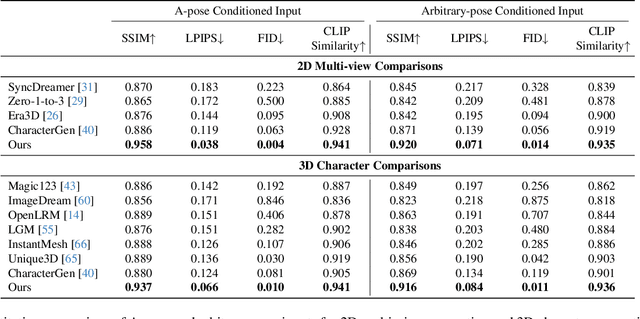

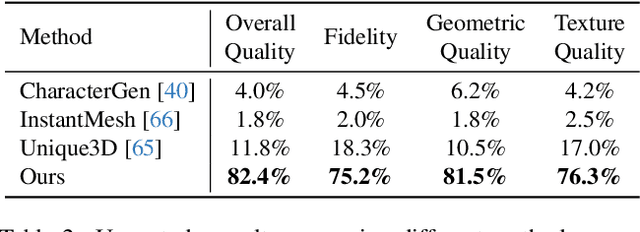
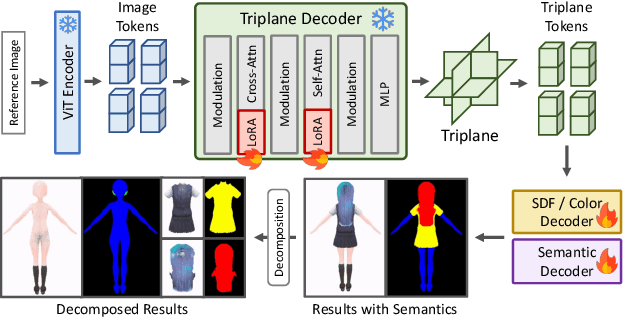
Abstract:We present StdGEN, an innovative pipeline for generating semantically decomposed high-quality 3D characters from single images, enabling broad applications in virtual reality, gaming, and filmmaking, etc. Unlike previous methods which struggle with limited decomposability, unsatisfactory quality, and long optimization times, StdGEN features decomposability, effectiveness and efficiency; i.e., it generates intricately detailed 3D characters with separated semantic components such as the body, clothes, and hair, in three minutes. At the core of StdGEN is our proposed Semantic-aware Large Reconstruction Model (S-LRM), a transformer-based generalizable model that jointly reconstructs geometry, color and semantics from multi-view images in a feed-forward manner. A differentiable multi-layer semantic surface extraction scheme is introduced to acquire meshes from hybrid implicit fields reconstructed by our S-LRM. Additionally, a specialized efficient multi-view diffusion model and an iterative multi-layer surface refinement module are integrated into the pipeline to facilitate high-quality, decomposable 3D character generation. Extensive experiments demonstrate our state-of-the-art performance in 3D anime character generation, surpassing existing baselines by a significant margin in geometry, texture and decomposability. StdGEN offers ready-to-use semantic-decomposed 3D characters and enables flexible customization for a wide range of applications. Project page: https://stdgen.github.io
MonoPlane: Exploiting Monocular Geometric Cues for Generalizable 3D Plane Reconstruction
Nov 02, 2024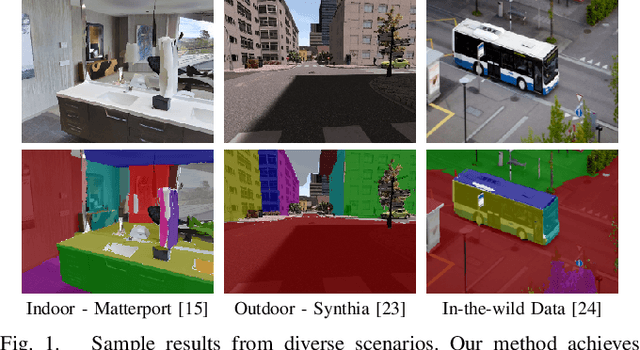
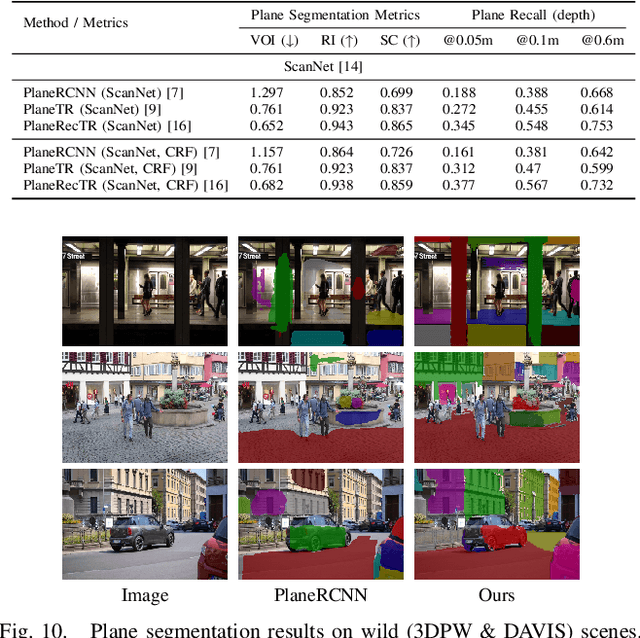
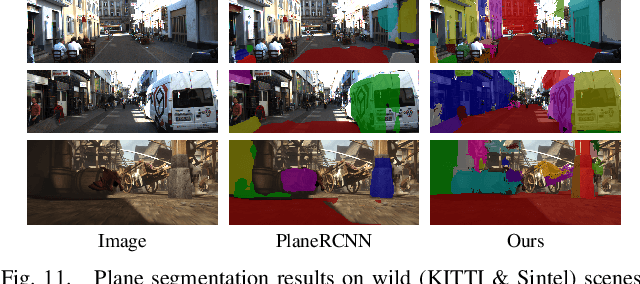
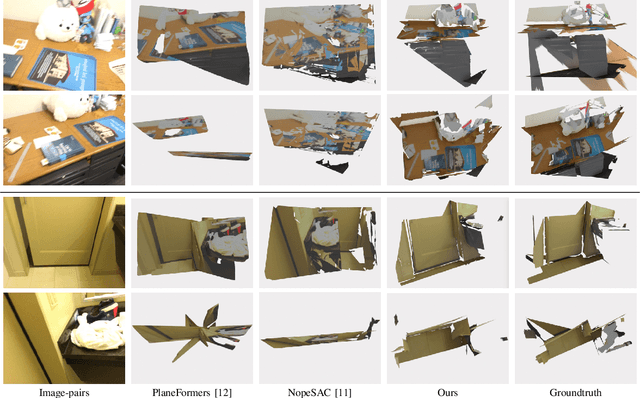
Abstract:This paper presents a generalizable 3D plane detection and reconstruction framework named MonoPlane. Unlike previous robust estimator-based works (which require multiple images or RGB-D input) and learning-based works (which suffer from domain shift), MonoPlane combines the best of two worlds and establishes a plane reconstruction pipeline based on monocular geometric cues, resulting in accurate, robust and scalable 3D plane detection and reconstruction in the wild. Specifically, we first leverage large-scale pre-trained neural networks to obtain the depth and surface normals from a single image. These monocular geometric cues are then incorporated into a proximity-guided RANSAC framework to sequentially fit each plane instance. We exploit effective 3D point proximity and model such proximity via a graph within RANSAC to guide the plane fitting from noisy monocular depths, followed by image-level multi-plane joint optimization to improve the consistency among all plane instances. We further design a simple but effective pipeline to extend this single-view solution to sparse-view 3D plane reconstruction. Extensive experiments on a list of datasets demonstrate our superior zero-shot generalizability over baselines, achieving state-of-the-art plane reconstruction performance in a transferring setting. Our code is available at https://github.com/thuzhaowang/MonoPlane .
Rectified Diffusion Guidance for Conditional Generation
Oct 24, 2024Abstract:Classifier-Free Guidance (CFG), which combines the conditional and unconditional score functions with two coefficients summing to one, serves as a practical technique for diffusion model sampling. Theoretically, however, denoising with CFG cannot be expressed as a reciprocal diffusion process, which may consequently leave some hidden risks during use. In this work, we revisit the theory behind CFG and rigorously confirm that the improper configuration of the combination coefficients (i.e., the widely used summing-to-one version) brings about expectation shift of the generative distribution. To rectify this issue, we propose ReCFG with a relaxation on the guidance coefficients such that denoising with ReCFG strictly aligns with the diffusion theory. We further show that our approach enjoys a closed-form solution given the guidance strength. That way, the rectified coefficients can be readily pre-computed via traversing the observed data, leaving the sampling speed barely affected. Empirical evidence on real-world data demonstrate the compatibility of our post-hoc design with existing state-of-the-art diffusion models, including both class-conditioned ones (e.g., EDM2 on ImageNet) and text-conditioned ones (e.g., SD3 on CC12M), without any retraining. We will open-source the code to facilitate further research.
LLM-based Optimization of Compound AI Systems: A Survey
Oct 21, 2024

Abstract:In a compound AI system, components such as an LLM call, a retriever, a code interpreter, or tools are interconnected. The system's behavior is primarily driven by parameters such as instructions or tool definitions. Recent advancements enable end-to-end optimization of these parameters using an LLM. Notably, leveraging an LLM as an optimizer is particularly efficient because it avoids gradient computation and can generate complex code and instructions. This paper presents a survey of the principles and emerging trends in LLM-based optimization of compound AI systems. It covers archetypes of compound AI systems, approaches to LLM-based end-to-end optimization, and insights into future directions and broader impacts. Importantly, this survey uses concepts from program analysis to provide a unified view of how an LLM optimizer is prompted to optimize a compound AI system. The exhaustive list of paper is provided at https://github.com/linyuhongg/LLM-based-Optimization-of-Compound-AI-Systems.
 Add to Chrome
Add to Chrome Add to Firefox
Add to Firefox Add to Edge
Add to Edge